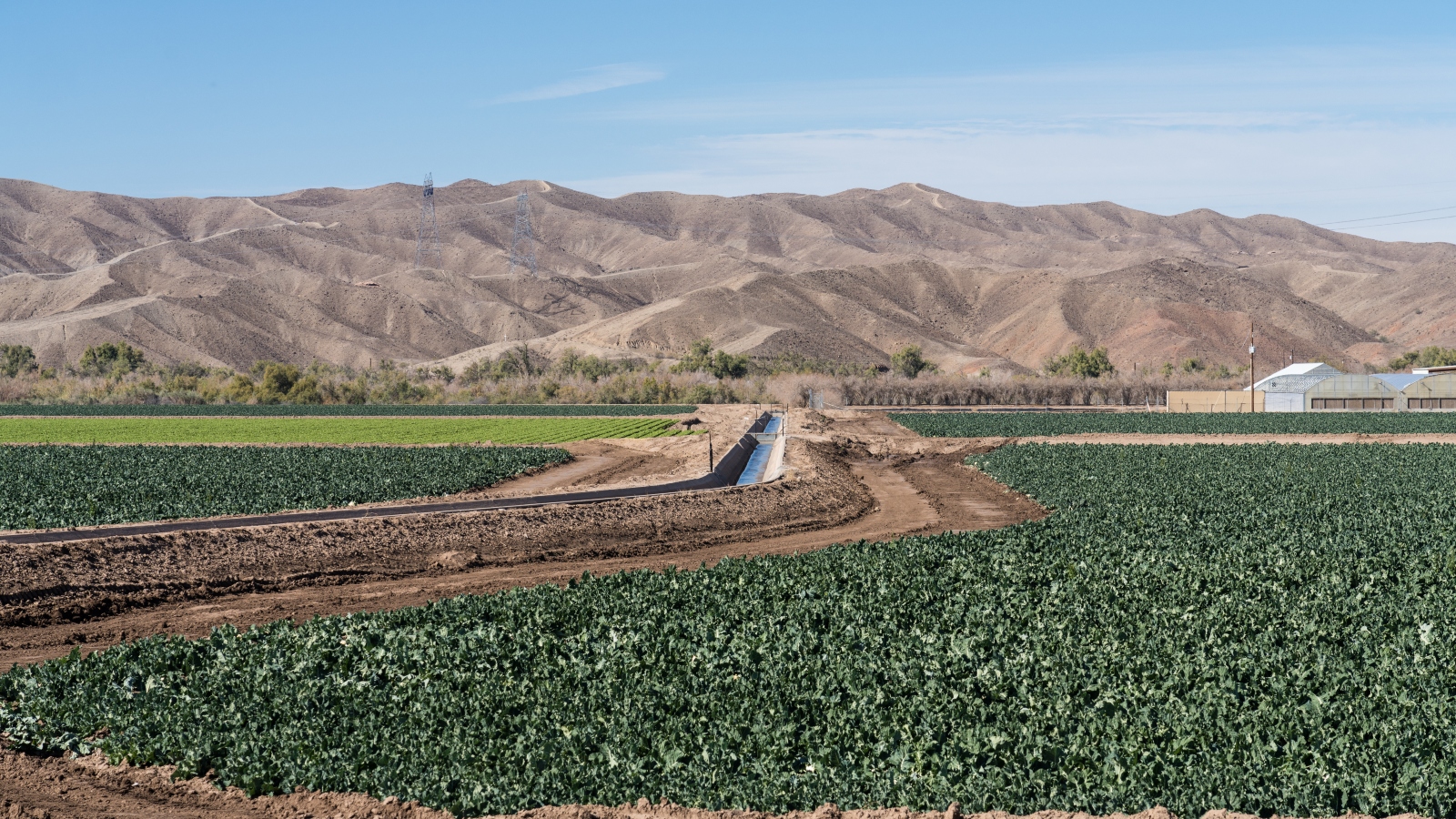Over the past few weeks, the planet, atmosphere, and ocean have hit historically high temperatures….
The post Earth Is at a Tipping Point: Take Action for a Sustainable Future appeared first on Earth911.

Over the past few weeks, the planet, atmosphere, and ocean have hit historically high temperatures….
The post Earth Is at a Tipping Point: Take Action for a Sustainable Future appeared first on Earth911.

At the turn of the 20th century, as the United States developed the West, the federal government built hundreds of hydroelectric dams on major rivers in the region. These dams destroyed river ecosystems and flooded Indigenous land, but they also provided a cheap and abundant source of renewable energy for tens of millions of people. Hydropower today meets around a quarter of the region’s energy needs.
But the hydroelectric fleet in the West has taken a beating over the past 20 years as a series of devastating droughts have battered the area. When major rivers dry up, less water flows through hydroelectric dam turbines — and dams produce less electricity as a result. At the same time, the heat waves that often accompany dry periods lead to more demand for power as people crank up their air-conditioning. That’s bad news for grid operators, who have to find an alternate source of electricity just as dams are falling short.
This decline in hydropower leads to a significant surge in fossil fuel emissions, according to a new study published last week in the Proceedings of the National Academy of Sciences, a leading scientific journal. After looking at power generation across the West between 2001 and 2021, the authors of the study found that coal and gas plants ramped up their activity during dry months to replace lost hydropower, leading to more carbon emissions and more local air pollution. While that finding was expected, the scale of the increase in fossil fuel emissions surprised the researchers.
“The effect on the power mix is actually pretty large,” said Minghao Qiu, a postdoctoral scholar at Stanford University who is the lead author of the study.
All in all, the decline in hydropower caused an extra 121 million metric tons of carbon emissions between 2001 and 2021 — about the same as if an additional 1.3 million cars had been on the road during the same period. The size of the change varied from grid to grid and from power plant to power plant, but it was considerable everywhere. Fossil fuel emissions rose by 11 percent in the Northwest during the driest months, and by a whopping 30 percent in California. At some plants, generation jumped as much as 65 percent above normal levels during dry spells.
During the driest years, this increase had staggering consequences for the climate: In 2001, for instance, a decline in hydropower caused fossil-powered plants in the West to emit 27 million tons more carbon dioxide than they otherwise would have, or about 10 percent of their total emissions from that year.
Because coal and natural gas tend to be more expensive to produce than hydropower, droughts likely led to higher energy costs for customers in the West. But the study also argues that declines in hydropower generation have come with big costs for the environment and public health — to the tune of more than $20 billion so far this century. Not only did the drought-driven rise in carbon emissions cause future warming that will lead to more climate disasters, but air pollution around fossil fuel plants also made nearby residents sicker, which will lead to greater public health costs later on.
In 2001, for instance, California’s natural gas plants ramped up to offset a drought-driven decline in hydropower across the region, leading to a more than 40 percent surge in emissions of toxic chemicals such as sulfur dioxide and nitric oxide.
These negative health effects didn’t always occur in the same places where a drought happened. When the hydropower fleet in a state like Washington faltered, grid operators imported electricity from other states, ferrying electrons over long transmission wires that crisscross the region. This replacement energy came from coal plants in Montana and gas plants in California, and people near those distant facilities bore the health costs as those plants burned more fossil fuels. The study found that more than half of the increase in fossil fuel generation from 2001 to 2021 happened in states that weren’t themselves experiencing drought.
“A climate shock in one place can really cause damages in faraway places, because the energy grid is so connected,” Qiu told Grist.
In an interesting twist, the study found that even a rapid renewable buildout might not fix the problem of more pollution during drought times. Western states are racing to build more solar and wind, and the Biden administration is pushing to build more of these facilities on the region’s abundant public land. But Qiu’s study found that fossil fuel plants will still provide backup power when other sources like hydropower fall short, since they can ramp up on short notice, unlike renewable sources that are dependent on the amount of sun and wind available. In order to tamp down fossil fuel emissions during dry spells, according to Qiu, states and the federal government need to work on developing better storage options, such as enhanced batteries, to preserve extra energy produced by renewables.
“We’re looking at the generators that increase their generation while there is a demand increase due to a heat wave or a supply decrease due to drought,” he told Grist. “If there is a future drought, it’s still going to be fossil fuel power plants that increase their generation to meet that gap of electricity.”
Update: This story has been updated to include a cumulative figure for carbon emissions attributable to hydropower loss.
This story was originally published by Grist with the headline How the Western drought has increased carbon emissions on Jul 10, 2023.
This story was originally published by Inside Climate News and is reproduced here as part of the Climate Desk collaboration.
June 2023 may be remembered as the start of a big change in the climate system, with many key global indicators flashing red warning lights amid signs that some systems are tipping toward a new state from which they may not recover.
Earth’s critical reflective polar ice caps are at their lowest extent on record in the satellite era, with the sea ice around Antarctica at a record-low extent by far, spurring worried scientists to share dramatic charts of the missing ice repeatedly. In the Arctic, the month ended with the Greenland Ice Sheet experiencing one of the largest June melt events ever recorded, and with scientists reporting that June 2023 was the hottest June ever measured, breaking the 2019 record by a “staggering” 0.16 degrees Celsius.
“With the record warmth in June, 2023 as a whole is now the odds-on favorite to be the warmest year on record,” climate scientist Zeke Hausfather wrote on Twitter.
Globally, the oceans set records for warmth on the surface and down to more than 6,000 feet deep throughout the month, with temperatures so far above the norm that the conditions elicited more graphs showing the anomaly. They’ve been shared thousands of times by scientists, policymakers, and the public. And in Canada, forest areas about the size of Kentucky have burned, choking huge swaths of central and eastern North America with acrid wildfire smoke, with some of the haze even reaching Europe.
There was record-breaking heat on nearly every continent during the month, according to independent climate statistician Maximilian Herrera. Along with the deadly late June heat in Mexico and the South-central United States, extreme readings have been widespread in remote Siberia, with hundreds of daily heat records, including readings higher than 95 degrees Celsius close to the Arctic Circle. “The heat will just get worse,” he posted on Twitter.
Herrera also tracks notable regional extremes, like a historic mountain heatwave in Iran, where temperatures in late June spiked to between 100 and 120 degrees Fahrenheit at elevations between 1,500 and 5,000 feet above sea level that are normally far cooler. During the first week of July, temperatures in Iraq are forecast to breach 120 degrees Fahrenheit.
“These extraordinary extremes could be an early warning of tipping points towards different weather or sea ice or fire regimes,” said University of Exeter climate researcher Tim Lenton. “We call it ‘flickering’ when a complex system starts to briefly sample a new regime before tipping into it. Let’s hope I’m wrong on that.”
In the meantime, the tropical Pacific Ocean is shifting into the warm El Niño phase of a two- to seven-year Pacific Ocean cycle that can boost the average global temperature by 0.2 degrees Celsius, enough to stoke the planet’s fever to a dangerous new high.
“The onset of El Niño will greatly increase the likelihood of breaking temperature records and triggering more extreme heat in many parts of the world and in the ocean,” said World Meteorological Organization Secretary-General Petteri Taalas. “Early warnings and anticipatory action of extreme weather events associated with this major climate phenomenon are vital to save lives and livelihoods.”
“I expect a step change to higher global mean temperatures starting this year,” said atmospheric scientist Kevin Trenberth, a distinguished scholar at the National Center for Atmospheric Research and honorary faculty at the University of Auckland. “And next year will be the warmest on record, either 1.4 or 1.5C above pre-industrial.”
The higher of those levels is the amount to which the United Nations’ 2015 Paris Agreement aspired to limit climate change, but the continued upward trajectory of global temperatures could make that goal impossible to reach.
“I expect it then to oscillate about that value and not come down again,” he said.
The El Niño temperature nudge comes against a backdrop of record-high carbon dioxide concentrations in the atmosphere, he said, adding that the rate of increase is as high as it has ever been and continues to accelerate.
“In other words, there is no bending down of the CO2 record, as should happen with all the new actions being taken in the U.S. and elsewhere,” he said. “The problem is that China and India are accelerating their coal-fired power stations and overwhelming all other cuts.”
The persistence of the startling Antarctic sea ice decline may be one of the most puzzling and worrisome of the recent cluster of climate extremes. Until recently, researchers expected less sudden changes in Antarctica, because it’s such a vast reservoir of coldness, and surrounded by a continual swirl of ocean currents and winds that have buffered the continent to some degree.
But at the end of June, getting into the heart of the Southern Hemisphere winter, an area of ice about the size of Texas and Alaska, nearly 1 million square miles, was missing. As the Southern Hemisphere’s winter set in, the sea ice grew more slowly than ever observed in the satellite era.
Sometimes, anomalies are just a one-time regional snapshot, but the Antarctic sea ice extent has been far below average at least since January, when Antarctic climate expert Ted Scambos, a senior scientist with Earth Science and Observation Center at the University of Colorado, Boulder, called the conditions extreme. “Frankly, we are still working to understand it,” he said.
But nearly every new study implicates human-caused warming, as measurements of winds and ocean currents show how the global temperature increase has pushed the Antarctic wind belt poleward, which also shifted relatively warmer water closer to the icy edges of the frozen continent.
Other recent research shows that the Southern Ocean encircling Antarctica and extending northward to 60 degrees south latitude, stored a disproportionately large percentage of the heat trapped in the atmosphere by greenhouse gases and then absorbed by the world’s oceans between 2005 and 2017. The study showed the Southern Ocean took up 45 to 62 percent of the heat absorbed by the world’s oceans, even though it makes up only 6.25 percent of the global ocean surface area.
In the absence of its reflective sea ice cover, the darker-colored ocean can absorb even more heat, potentially leading to earlier and more extensive melting during the next Austral summer. And as the fringe of ice around Antarctica gets smaller, warmer ocean water can more easily flow toward the floating ice shelves that buttress vast areas of inland ice that could start flowing into the sea faster to speed sea level rise.
There are also ecosystem impacts. The abundance of certain types of plankton and krill, at the base of the ocean food chain, is linked with the Antarctic sea ice. A disruption to those organisms ripples up through the ecosystem, because the feeding and breeding cycles of many other species, including seals and seabirds, is closely linked with sea ice.
Climate scientist Michael Mann, director of the Center for Science, Sustainability & the Media at the University of Pennsylvania, said there is probably a global warming fingerprint on the deadly dome of stagnant, hot air that is baking large parts of Mexico, the Southwestern and central United States and Canada.
“Also playing a role in the extreme weather we’re seeing, including the (south-central U.S. heat dome and the Canadian wildfires) is what appears to be another resonance event,” he said, referencing research that shows how the warming climate favors planetary atmospheric wave patterns that “can give rise to persistent summer weather extremes. In this case, it is likely behind many of the extreme conditions we’re seeing right now in North America and Eurasia.”
Another part of the heat dome settled over Canada, where wildfires had released 160 million tons of carbon by the end of June, the highest annual total estimated emissions for Canada since satellite monitoring began in 2003, scientists with the EU’s Copernicus Atmospheric Monitoring Service reported. And there’s also new research suggesting links between vanishing ice and snow in the planet’s polar reaches and climate extremes in the mid-latitudes, where most people live.
“The pile of evidence linking a rapidly warming Arctic with extreme summer weather events continues to grow,” climate scientist Jennifer Francis wrote on Twitter on June 30, sharing a link to a new peer-reviewed study in Nature Communications that solidifies the hypothesis that changes in the Arctic can lead to a wavier jet stream that can trap heat domes in place.
In recent years, those patterns have sometimes persisted for months with only short pauses, including last summer, when a heat dome over Europe lasted several months and fueled that continent’s hottest summer on record.
At the top of the planet, scientists have been watching an extreme ocean heat wave in the North Atlantic just as carefully, because it could be a symptom of disruption to the Atlantic Meridional Overturning Circulation, a critical part of the global climate system that transports cold and warm ocean water between the poles. Sea surface temperatures about 9 degrees Fahrenheit above average in the region could also contribute to heatwaves over adjacent land areas.
Record-breaking ocean temperatures in regions around the globe are not surprising Trenberth, who specializes in analyzing deep ocean heat content, down to more than 6,000 feet below sea level, where more than 90 percent of all the heat trapped in the atmosphere by carbon pollution has been absorbed.
That heat is measured as energy rather than as a temperature value, and it’s equivalent at this point to the energy of five nuclear bombs exploding in the ocean each second, or about 100 times more energy than all the electricity produced in 2021 globally.
For Trenberth, that global energy imbalance, building steadily since the start of the fossil-fueled industrial age, is the best measure of how humans have affected the climate, because the energy balance isn’t affected by seasonal or annual variations, or by shifts in regional climate patterns.
And if the heat building that energy imbalance in the oceans was to stop, many of its impacts would rapidly decrease, even though the water is warmer.
“It is not global temperature that matters but Earth’s energy imbalance. If you have a pot of water on the stove, while heating, convection occurs,” he said. “Ultimately it boils off water as steam. But as soon as you turn off the heat source, all that behavior stops. The temperature is the same, but the heating is no more.”
This story was originally published by Grist with the headline Parts of the climate system are reaching tipping points, June extremes suggest on Jul 9, 2023.

Since the beginning of the 21st century, the western United States has been experiencing some of the driest conditions on record, and according to the UN, more than 75% of the world could be facing drought conditions by 2050. Bottom line: as climate change continues to cause water stress, we need to find ways to conserve water and adapt to drier conditions — including in our yards and gardens.
The traditional expanses of pristine green grass that characterize most lawns use huge amounts of water. It’s estimated that 30% of residential drinking water is used outdoors, and even more in the summer. This can be a huge expense and a drain on water resources, especially in areas of the country facing water shortages.
The goal of creating a water-wise yard is threefold: to increase the amount of moisture your soil can hold, capitalize on naturally available water, and choose plants and designs that require less water to begin with. Landscaping using water-wise methods is often called “xeriscaping,” a term first used by the Denver Water Board to describe landscaping methods that reduce the need for irrigation, capitalize on natural precipitation, and overall require less water than traditional landscaping methods. Whatever the name, there are many ways to increase the resilience of your yard in the face of drought.

Usually integrated with xeriscaping, hardscaping basically means designing and decorating your yard with non-organic features like walls, paths, patios, or driveways. Hardscaping itself is not inherently sustainable, but sustainable hardscaping works in harmony with the ecosystem, built intentionally with the goal of having a positive effect on the environment rather than a negative one.
A primary feature of sustainable hardscaping is allowing for permeability, which traditional materials and methods — like building expanses of unbroken concrete for patios or sidewalks — don’t reflect. These impermeable surfaces don’t allow water to percolate through to the soil, but instead allow it to run off to other areas and deprive the soil of water. Using materials like gravel or stones with gaps in between to build walkways and other yard features will allow rainwater to infiltrate rather than run off.
After a heavy rain, you might notice that water pools in a specific area of your yard, or rushes down gulleys in the dirt. Building a dry creek bed from rocks in the areas where water usually collects will force it to percolate back into the soil. There are many different ways to design these beds, but the main goal is to dig a trench, using the displaced soil to build up the walls. Line the bed with larger rocks, and cover the inside with medium-sized rocks. There will be some spaces in between, which you can fill in with gravel or river rock.
To beautify the creek bed, plant some native greenery along the top of the trench around the large rocks, or create a rain garden at the bottom with your garden’s moisture-loving plants to put that water to use and prevent further erosion.
Using municipal water to water your garden can be expensive — especially in the heat of summer — and some municipalities facing water shortages might impose restrictions on water use for yards and gardens. Instead, use the water that’s being given to you for free! Capture rainwater in a store-bought rain barrel, or make an easy DIY version yourself. Most connect to a drain spout, and have a spigot at the bottom for easily accessing the water. For a low-tech solution, put out some buckets and barrels right before a rainstorm to collect water for tomorrow’s watering. Note that collected rainwater should never be used for drinking, and when watering the garden, water plants right at their base in case of any contaminants in the water, then thoroughly wash any produce.

Kentucky bluegrass — the grass that usually coats our lawns — is thirsty, and requires a lot of water to stay green. Choosing plants with greater tolerance to low-water conditions will require less attention, and less water.
Unlike annuals — which have a single-year life cycle — perennials overwinter in gardens and come back year after year. Because of this, their root systems are robust and much more well-established, meaning they require less watering. Planting perennials also results in less soil disturbance (since you aren’t replanting every year), which leaves the organic matter of the soil intact and thus maintains high water retention. Foxglove beardtongue, purple coneflower, yarrow, and Russian sage are among the many beautiful perennials that are especially drought-tolerant.

Because they only live for one year, annuals have shallow roots and generally require more water than perennials. However, some annuals — like California poppies, cleomes (or “spider flowers”), cosmos, creeping zinnias, marigolds, sunflowers, and vinca (aka periwinkle) — have a higher tolerance for drought. For grasses and greenery, try fountain grass, pampas grass, blue fescue, lamb’s-ear, and sweet potato vine. Succulents and cacti do especially well without much water, although check the tag to make sure they are suited for your hardiness zone.
Among all of the options for ornamental plants, you’ll likely find the greatest success with those that naturally grow in your region. Native plants have adapted over time to the climate, soil, and other local conditions, which means they don’t require as much attention, are more resistant to pests and disease, and usually require less water. Blanketing your yard with species native to your area will lead to a biodiverse, successful, and water-wise yard.

Put your thirstiest plants in the same area of the garden, especially if you water with a hose. By concentrating your heavy watering into just one area (rather than all over the yard), you’ll save a good deal of water; even just walking around with the hose spraying as you move from area to area can be a drain on water.
Paying attention to the health of your soil is important for growing robust plants above the ground. While soil composition varies widely by region, healthy soil acts like a sponge, retaining water for when the plants need it while still being porous enough for roots to penetrate. Organic matter increases the water-retention capacity of soil — add compost at the beginning of the growing season to deliver more nutrients to the ground before planting.
A layer of mulch overtop a garden can greatly reduce loss of moisture through evaporation. Store-bought wood chips aren’t the only option for mulching — fallen leaves, leaf mold, pine needles, and grass and garden clippings will work just as well. When you chop perennials at the end of their life, (or do any pruning of plants) leave the clippings over top of the soil to trap in moisture. Inorganic mulch like gravel and shells can work, but it can make it harder to work in the garden.
Both wind and strong sunlight can decrease soil moisture during the day. To combat this, plant tall shrubs and plants around the perimeter of the garden to act as a barrier. Before doing this, notice how shadows work in your yard, and plant accordingly. Some plants want full sun all day, so plant those away from the shade, and plant more shade-loving plants closer.

When watering with the hose, we tend to spray over a wide range, likely wetting areas that don’t need the moisture. In general, plants do better with less frequent waterings that penetrate deeper into the soil, which encourages them to grow deeper root systems. Instead of a typical garden hose, try a drip irrigation system or soaker hose instead, which targets the roots directly and wastes no water in the process.
These low-tech, relatively inexpensive tools measure the amount of water your garden is getting so you can adjust your watering schedule accordingly — you may be watering much more than is necessary without realizing. Most gardens are okay with one inch of water per week (although arid climates will need slightly more), aside from especially hot periods. When you water, check to make sure the soil actually needs it. If it’s dry an inch below the surface, it’s time to water, but if not, wait until it’s dried out a bit more.
The post Low-Water Landscape and Garden Designs for Water-Wise Yards appeared first on EcoWatch.
This story was originally published by the Guardian and is reproduced here as part of the Climate Desk collaboration.
Marginal improvements to agricultural soils around the world would store enough carbon to keep the world within 1.5C of global heating, new research suggests.
Farming techniques that improve long-term fertility and yields can also help to store more carbon in soils but are often ignored in favor of intensive techniques using large amounts of artificial fertilizer, much of it wasted, that can increase greenhouse gas emissions.
Using better farming techniques to store 1 percent more carbon in about half of the world’s agricultural soils would be enough to absorb about 31 gigatons of carbon dioxide a year, according to new data. That amount is not far off the 32 gigaton gap between current planned emissions reduction globally per year and the amount of carbon that must be cut by 2030 to stay within 1.5C.
The estimates were carried out by Jacqueline McGlade, the former chief scientist at the UN environment program and former executive director of the European Environment Agency. She found that storing more carbon in the top 30 centimeters of agricultural soils would be feasible in many regions where soils are currently degraded.
McGlade now leads a commercial organization that sells soil data to farmers. Downforce Technologies uses publicly available global data, satellite images, and lidar to assess in detail how much carbon is stored in soils, which can now be done down to the level of individual fields.
“Outside the farming sector, people do not understand how important soils are to the climate,” said McGlade. “Changing farming could make soils carbon negative, making them absorb carbon, and reducing the cost of farming.”
She said farmers could face a short-term cost while they changed their methods, away from the overuse of artificial fertilizer, but after a transition period of two to three years their yields would improve and their soils would be much healthier.
She estimated it would cost about $1 million to restore 40,000 hectares (99,000 acres) of what is currently badly degraded farmland in Kenya, an area that is home to about 300,000 people.
Downforce data could also allow farmers to sell carbon credits based on how much additional carbon dioxide their fields are absorbing. Soil has long been known to be one of Earth’s biggest stores of carbon, but until now it has not been possible to examine in detail how much carbon soils in particular areas are locking up and how much they are emitting. About 40 percent of the world’s farmland is now degraded, according to UN estimates.
Carbon dioxide removal, the name given to a suite of technologies and techniques that increase the uptake of carbon dioxide from the air and sequester the carbon in some form, is an increasing area of interest, as the world slips closer to the critical threshold of 1.5C of global heating above pre-industrial levels.
Arable farmers could sequester more carbon within their soils by changing their crop rotation, planting cover crops such as clover, or using direct drilling, which allows crops to be planted without the need for ploughing. Livestock farmers could improve their soils by growing more native grasses.
Hedgerows also help to sequester carbon in the soil, because they have large underground networks of mycorrhizal fungi and microbes that can extend meters into the field. Farmers have spent decades removing hedgerows to make intensive farming easier, but restoring them, and maintaining existing hedgerows, would improve biodiversity, reduce the erosion of topsoil, and help to stop harmful agricultural runoff, which is a key polluter of rivers.
This story was originally published by Grist with the headline Soil improvements could keep planet within 1.5C heating target, research shows on Jul 8, 2023.
From January to June of this year — the first six months of Luiz Inácio Lula da Silva’s presidential term — deforestation in Brazil’s Amazon has fallen 33.6 percent, new government satellite data shows, as The Associated Press reported.
Lula’s stricter environmental rules led to 1,023 square miles of cleared rainforest during that time frame, compared with the same period in 2022 when 1,544 square miles were cleared under Jair Bolsonaro.
It was the lowest level of deforestation for the period in four years, reported Reuters.
“The effort of reversing the curve of growth has been reached. That is a fact: we reversed the curve; deforestation isn’t increasing,” said João Paulo Capobianco, the environment ministry’s executive secretary, during a presentation in Brasília, as The Associated Press reported.
The deforestation rate for June — the beginning of the dry season, a time when it tends to go up — was down 41 percent.
During his campaign, Lula promised to stop the destruction of the rainforest that had become a hallmark of Bolsonaro’s presidency.
The peak period for forest clearing and fires in the Amazon is from July to October.
“July tends to have an explosion in deforestation,” Capobianco said, as reported by Reuters.
According to the Rainforest Trust, the Amazon rainforest produces about one-fifth of the planet’s oxygen. It also stores a good portion of the world’s carbon. But when forests are cleared, that carbon is released into the atmosphere, contributing to climate change.
“Bottom line, we are prioritizing environmental law enforcement,” Jair Schmitt, head of environmental protection at Brazil’s federal environmental agency Ibama, told The Associated Press.
Schmitt said there has been a personnel shortage, as many Ibama agents retired during Bolsonaro’s term and weren’t replaced in an effort to remove environmental officials.
Though Lula has made a commitment to bring the number of agents back up, it is currently the lowest in 24 years, with only 150 available for service.
In some cases, the owner of a specific piece of land that has been deforested can be identified by comparing land records with satellite data, and sanctions can be imposed, Schmitt said.
One type of deterrent is for cattle that have been raised illegally to be seized in embargoed areas.
Ibama head Rodrigo Agostinho said the agency imposed embargoes on 2,086 areas in the first half of 2023, a 111 percent jump from the average of the previous four years.
June of this year saw the most fires in the Amazon rainforest since 2007, an increase Schmitt attributed to deforestation and forest clearing in the last six months of 2022.
“It’s very positive, but we continue to have very high levels of deforestation,” said Daniel Silva, an analyst at nonprofit WWF-Brasil, as Reuters reported.
The post Amazon Deforestation Drops 33% in Lula’s First Six Months appeared first on EcoWatch.

The International Maritime Organization, or IMO — the United Nations body in charge of regulating the global shipping industry — wrapped up two weeks of negotiations on Friday with an agreement that the industry should reach net-zero greenhouse gas emissions “around” 2050.
That’s an improvement over the IMO’s previous climate target for the sector — to merely halve emissions by midcentury — but it’s left many environmental advocates severely disappointed.
“There is no excuse for this wish-and-a-prayer agreement,” John Maggs, president of the Clean Shipping Coalition, said in a statement. Others called it a “historic failure” and a “wishy-washy compromise.”
Negotiators sealed the deal on Friday following 10 days of heated discussions meant to address the shipping industry’s outsize carbon footprint. Cargo ships, which carry goods and materials across oceans and are responsible for almost all international trade, account for about 3 percent of humanity’s overall carbon emissions — about as much as Germany.
In order to limit global warming to 1.5 degrees Celsius (2.7 degrees Fahrenheit) — the target countries agreed to in the 2015 Paris Agreement — experts have estimated that the shipping industry must cut emissions by 45 percent by 2030 before reaching near-zero emissions in 2040.
Those are the targets that a coalition of Pacific Island countries, plus a few allies including the United States and the U.K., were advocating for at the IMO summit. “Anything less than 36 percent by 2030 and 96 percent by 2040 will be detrimental” to reaching international climate goals, the Marshall Islands negotiator Albon Ishoda told journalists at the summit last week.
Instead, the agreement set a decarbonization deadline for “by or around, i.e., close to 2050,” with the justification that this would provide greater flexibility for poorer developing countries. (Countries will be responsible for setting policies to achieve the emissions reductions.) The final agreement also included interim targets for 2030 and 2040, although they are far less ambitious than what scientists and many developing countries had been hoping for. The nonbinding agreement asks the shipping industry to reduce emissions by at least 20 percent by 2030 and 70 percent by 2040. It says the industry should continue “striving” for greater reductions of 30 percent and 80 percent.

“Nations failed to put the shipping industry on a credible, 1.5-degree C pathway,” said Madeline Rose, senior climate campaign director for the nonprofit Pacific Environment. She said the IMO’s agreed-upon strategy would exhaust the shipping industry’s carbon budget for limiting warming to 1.5 degrees by 2032, although individual governments and shipping companies could take more aggressive action to prevent that from happening.
Several groups said the only reason there were any interim targets at all was because of a handful of negotiators from small island states, including Vanuatu and the Marshall Islands. These negotiators, whose countries are particularly sensitive to sea-level rise and other climate impacts, eked out stronger targets in the face of heavy opposition from oil-exporting countries like Saudi Arabia, which stand to gain from continued reliance on a fossil fuel-powered shipping sector.
Larger developing countries like Brazil and Argentina also argued that any reduction in climate pollution would cause them disproportionate economic harm — despite evidence to the contrary. A widely cited report published late last month found that existing solutions — some as simple as reducing ships’ speeds — could reduce global shipping emissions by up to 47 percent below 2008 levels by 2030, with minimal impacts to global trade.
Other solutions in the report, published by the consulting firm CE Delft, include adopting wind-assisted propulsion technologies and replacing 5 to 10 percent of ships’ heavy fuel oil with zero-emissions alternatives like green hydrogen and green methanol.
Maggs said countries baselessly refuted the report and others like it as if they were in a “Trumpian, post-truth alternative reality.” He said the shared desire to come to some kind of agreement gave the obstructionist countries outsize negotiating power. Delegates were “prepared to put up with a weak agreement,” he said, so long as they produced something by the end of the summit.
In addition to the emissions targets, the IMO’s agreement reached on Friday also includes a “basket of measures” to help them reach the new goals. One is an international fuel standard for greenhouse gases, similar to what the IMO has already adopted for sulfur oxide pollution. The other is a global levy on shipping emissions that could generate revenue to fund the shipping industry’s transition away from heavy fuel oil. Both measures are set to be designed in greater detail over the coming years, with implementation scheduled for no later than 2027.

The levy in particular proved controversial, and many consider its inclusion in the agreement a major success. More than 70 developing and developed countries supported it, while Brazil, Argentina, and China, the world’s largest exporter, led a coalition to oppose it. In a diplomatic note delivered to developing countries last month, Beijing officials said the levy was “a disguised way by developed countries to improve their own market competitiveness.”
None of the IMO’s newly agreed-upon targets are mandatory, meaning the onus will now fall on member states for compliance and enforcement. Many environmental advocates are hopeful that national policies will nudge the shipping industry to decarbonize faster, although this will likely lead to a more confusing tangle of standards than if the IMO had unified countries around a single set of science-based targets. “It’s not ideal,” said Delaine McCullough, shipping emissions campaign manager for the nonprofit Ocean Conservancy. “But it needs to happen.”
In the U.S., for example, the recently introduced federal Clean Shipping Act would set emissions standards for shipping companies that dock at American ports, requiring them to align with a pathway toward net-zero by 2040. Other proposed laws like the International Maritime Pollution Accountability Act, which would place a pollution fee on large ships unloading cargo at U.S. ports, could serve as policy models on the international stage.
Individual cities and ports can implement similar regulations on their own, before federal policies are passed. Freight companies can take action too. The shipping giant Maersk, for example, is aiming for net-zero by 2040 and has committed not to buy new ships unless they can run on carbon-neutral fuel. It recently announced the world’s first effort to retrofit a fossil fuel-powered ship to run on green methanol.
“[T]he time to act is now,” Marie Cabbia Hubatova, global shipping director for the nonprofit Environmental Defense Fund, said in a statement. “This is our last chance to get shipping close to Paris Agreement alignment and set the standard for other hard-to-abate sectors.”
This story was originally published by Grist with the headline UN sets ‘wishy-washy’ climate target for global shipping industry on Jul 7, 2023.
A new study, led by researchers at the University of Washington, has linked mass seabird die-offs to marine heat waves.
The study, published in the journal Marine Ecology Progress Series, analyzed data collected from residents along coasts from Alaska to central California from 1993 to 2021. The researchers were looking to find if these marine heat wave events were affecting seabirds, which are near the top of the food chain for coastal regions.
The analysis of over 90,000 surveys of beached seabirds shows the marine heat waves do impact the seabirds over time. The study found die-offs occurred more frequently following heat waves. In one particular case, the researchers found a sequence of die-offs 1 to 6 months and 10 to 16 months in the California Current, a marine ecosystem, after three prolonged marine heat waves.
“We find a dramatic delayed effect,” Julia Parrish, co-author and a professor of aquatic and fishery sciences at the University of Washington and executive director of the Coastal Observation and Seabird Survey Team (COASST), said in a news release. “A warmer ocean, and certainly a suddenly warmer ocean as happens during an El Niño or a marine heat wave, will result in the death of hundreds of thousands to millions of marine birds within one to 6 months of the temperature increase.”
The study authors have previously found links from warming ocean waters to die-offs in specific seabird species, such as common murres and Cassin’s auklets. The higher water temperatures cause changes to the availability of the birds’ prey, the previous studies found.
The most recent research takes a more general look at 106 different species around over 1,000 beaches. Seabirds started washing ashore usually a few months after a marine heat wave began, according to the data. Murres, puffins, auklets and shearwaters were among the most impacted species.
The die-offs happened for many reasons, such as algal blooms, diseases and starvation, all of which were linked to marine heat waves. Some of the worst massive die-offs, with more than 250,000 bird deaths, occurred about once per decade, except from 2014 to 2019, which had five massive mortality events.
“This is unprecedented,” lead author Timothy Jones, a University of Washington research scientist in aquatic and fishery sciences, said in a statement. “This type of massive die-off can be compared to a catastrophic storm that we would usually expect once per decade; they happen, causing massive damage, but usually there is enough time for areas to recover.”
But in recent years, there’s less recovery time before another marine heat wave leads to massive damage. The study warns that with increasingly warming oceans, there could be more severe mortality events. Already this year, ocean surface temperatures reached a record high, and El Niño could bring more record-breaking temperatures.
The post Seabird Die-Offs Linked to Marine Heat Waves appeared first on EcoWatch.
Recommerce is on the rise as retail locations struggle to attract customers after the pandemic,…
The post Earth911 Podcast: B-Stock’s Marcus Shen on Growing the Resale Economy appeared first on Earth911.